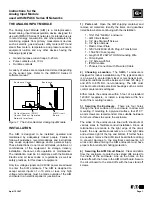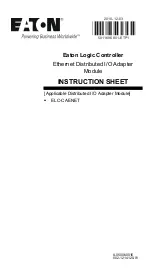
D.4.f. Oxygen Sensor Corrections
The Exhaust Gas Oxygen (EGO) Sensor can provide for fuel injector pulse width modifications. In
the software, the Air-Fuel Ratio Table defines the desired air-fuel ratio at the various operating points of
the engine. When the EGO is turned on (in closed loop operation), the
TECgt
will try to correct the
injector pulse width to make the EGO reading the same as the numbers in the Air-Fuel Ratio Table. This is
accomplished by sampling the reading from the EGO sensor, and adjusting the injector pulse width
accordingly.
An EGO reading that is numerically lower than the table value indicates a richer-than-desired
air-fuel ratio
. When this occurs, the
TECgt
will begin to shorten the injector pulse width. It does this by
decreasing the “VE Absolute” percentage.
An EGO reading that is
numerically higher than the table value indicates a leaner-than-
desired air-fuel ratio
. When this occurs, the
TECgt
will begin to increase the injector pulse width. It
does this by increasing the “VE Absolute” percentage.
When discussing the air-fuel ratio of an engine, these terms are often used:
•
Air-Fuel Ratio (AFR):
The ratio of incoming air mass to incoming fuel mass. A rich
mixture would have a comparatively small ratio between the air and fuel (like 12:1), while a
lean mixture would have a comparatively larger ratio between the air and fuel (like 16:1).
Oxygen sensors measure the leftover oxygen content in the exhaust to try to determine this
ratio.
•
Stoichiometric:
A chemically balanced air-fuel ratio that will result in (theoretically) zero
excess fuel or excess air in the exhaust. For gasoline, this number is 14.64 parts air to 1 part
fuel by mass. Thus, for gasoline, the stoichiometric air-fuel ratio is 14.64:1. Different fuels
have radically different stoichiometric ratios.
•
Lambda:
The ratio of actual air-fuel ratio to stoichiometric air-fuel ratio. For a gasoline
engine running at 14.64:1, lambda is 14.64
÷
14.64 = 1. For an engine running at 12.5:1,
lambda is 12.5
÷
14.64 = 0.85 . Thus, lambda normalizes the stoichiometric air-fuel ratio for
comparison of different fuels.
•
Rich Mixture:
Excess fuel in the combustion process.
•
Lean Mixture:
Excess air in the combustion process.
•
Closed Loop:
When the ECU corrects the injector pulsewidths to obtain air-fuel ratios from
the “Desired Air-Fuel Ratio Table,” it is operating in closed loop mode.
•
Open Loop:
When the ECU is not trying to correct to the “Desired Air Fuel Ratio Table,”
it is operating in open loop mode.
A few factors control the manner in which the TECgt alters the air-fuel ratio:
EGO Parameters
•
EGO Feedback Control Activation:
This defines whether or not the oxygen sensor is set for
closed-loop operation.
•
Coolant Temp. Above Which EGO is Enabled:
Allows the EGO to be turned off on cold
engines. This is necessary because the EGO sensor must warm up before its readings are accurate.
EGO Reactivity and Authority
•
Instantaneous AFR Error Divisor:
Defines the size of the injector pulse width modifications
when instantaneously large errors occur in the AFR (termed the “instantaneous error”). Large
numbers for this parameter cause small pulse width modifications. Small numbers for this
parameter cause large pulse width modifications. This number is used to control engine speed
______________________________________________________________________________________
TECgt Manual Version 2.0
- Page 67 -
©2008 Electromotive, Inc.
















































